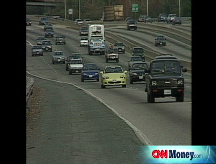Americans ditching the car
Commuters are driving less, the federal government says. Workers are leaving their cars at home and finding other ways to get to work. Highway funds at risk.
 |
| Eric Creese says he's biked 1,000 miles to work since May and saved about $250 in gas. |
NEW YORK (CNNMoney.com) -- Americans drove 9.6 billion fewer miles in May compared with a year earlier, according to a report Monday from the Federal Highway Administration.
"We have seen the longest decline in vehicular miles traveled since we started collecting this data," said U.S. Transportation Secretary Mary E. Peters in a conference call with reporters.
Peters said that in the first four months of this year, Americans traveled 40.5 billion miles less compared with the same period in 2007. She said the decline in usage means less tax revenue for highway system.
Many of these commuters are flocking to trains, buses and bikes, or telecommuting from home.
Rising gas prices are to blame for the driving decline, and the use of public transportation is soaring, said Virginia Miller, spokeswoman for the American Public Transit Association, a private trade group.
"It does seem that we are on track to beat last year's record [public transportation] ridership," she said, noting that the 2007 tally of 10.3 billion public transit trips was a 50-year high.
"That can really only be explained by the large increase in gas prices," said Miller.
Gasoline prices soared in May, rising for 24 consecutive days in the month, and breaking the psychologically significant $4-a-gallon barrier in many states, according to data from motorist group AAA.
The FHA said that driving in May experienced the third-largest monthly drop since the agency, a division of the U.S. Department of Transportation that manages the nation's highways and bridges, began collecting data 66 years ago. It was the largest drop for any May, a month that usually sees driving increase due to the Memorial Day holiday, the agency said. Three of those largest monthly declines have occurred since December, as unusually high fuel prices take a toll on drivers.
Many of these drivers switched to public transportation. Usage jumped in the first three months of the year by 88 million trips from a year ago, for a total of 2.6 billion, according to the most recent figures available from the APTA.
Some of the most dramatic increases occurred in the light rail systems in Baltimore, Minneapolis and St. Louis, the commuter rails of Seattle and Harrisburg, Penn., the buses of San Antonio and Denver, and the subways and elevated rails of and Boston.
The Boston Globe reported Monday that the Massachusetts Bay Transportation Authority broke a ridership record of 375 million passengers in fiscal year 2008, which is 21 million more than the prior year.
Other commuters, like Eric Creese, a senior database administrator in Eagan, Minn., switched to muscle power for commuting. Creese, a former triathloner, said that high gas prices inspired him to "get back" into biking.
"I asked myself, 'Why drive 150 miles a week when I can save my car, my money and do something good for my body and environment,?'" said Creese, who said he has biked 1,000 miles to work since May and saved about $250 in gas.
Now Creese runs a Web site - GasFreeCommute.com - for bike commuters, with calculators to estimate calories burned and gasoline saved. His co-workers have logged their miles on his site, totaling 5,400 so far.
And if commuters really want to save money, they'll stay at home, said Chuck Wilsker, president and co-founder of The Telework Coalition. Wilsker estimates the nationwide tally of telecommuters to increase by 4 or 5 million workers this year, from an estimated 28 million at the start of 2008.
"If you want to quickly reduce your commuting costs by 20%, leave your car at home one day a week; if you want to reduce your costs by 40%, leave your car at home two days," said Wilsker, who telecommutes from his suburban Maryland home to Washington, D.C.
Not only does Wilsker save on gas, but he said he saves on automotive wear and tear, lunch and dry cleaning.
"You know what I'm wearing?" said Wilsker. "I'm wearing shorts, sandals and a tank top. I'm sitting here working from home. My dry cleaning bill is none."
As high fuel costs led many to rely on other forms of transportation, such as mass transit, and to cut back their miles on the road this year, the reduced driving also sliced tax revenue that would normally go toward highway maintenance, the FHA said.
The federal tax on gas generates 18.4 cents per gallon of regular gas sold and 24.4 cents per gallon for diesel fuel, which gets pumped in to the federal Highway Trust Fund. Some states also add a tax of their own to fund various projects.
The FHA budget totaled $42.18 billion in fiscal year 2008. The Bush Administration has requested $40.14 billion for fiscal year 2009.
As Americans drive less, new ways are needed to fund the national road system, the highway agency said. Even though fewer drivers are using the highways, funding is still critical, party because of a backlog in highway projects.
Peters said she would unveil a new plan on Tuesday to "fundamentally reform our nation's transportation." She said much of the plan will focus on calculating a better cost-benefit analysis for maintaining the national highway system, as well as "weaning ourselves from the gas tax over time." ![]()





